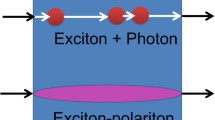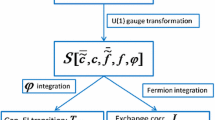Abstract
Correlations of the luminescence intensity (the second-order correlation function g (2)(τ)), where τ is the delay time between the photons detected in pairs) under the conditions of the Bose-Einstein condensation (BEC) of dipolar excitons has been studied in a temperature range of 0.45–4.2 K. Photoexcited dipolar excitons have been accumulated in a lateral trap in a GaAs/AlGaAs Schottky diode with a 25-nm wide single quantum well with an electric bias applied across the heterolayers. Two-photon correlations have been measured with the use of a two-beam intensity interferometer with a time resolution of }~0.4 ns according to the well-known classical Hanbury-Brown-Twiss scheme. The photon bunching has been observed at the onset of Bose-Einstein condensation manifested by the appearance of a narrow exciton condensate line in the luminescence spectrum at an increase in the optical pum** (the line width near the threshold is ≲200 μeV). At the same time, the two-photon correlation function itself obeys the super-Poisson distribution, g (2)(τ) > 1, at time scale τc ≲ 1 ns of the system coherence. The photon bunching is absent at a pum** level substantially below the condensation threshold. The effect of bunching also decreases at pum** significantly above the threshold, when the narrow exciton condensate line starts to dominate in the luminescence spectra, and finally disappears with the further increase in the optical excitation. In this region, the distribution of pair photon correlations is a Poisson distribution manifesting the united quantum coherent state of the exciton condensate. Under the same conditions, the first-order spatial correlation function g (1)(r) determined from the interference pattern of the luminescence signals from the spatially separated parts of the condensate at constant pum** remains noticeable at distances of no less than 4 μm. The discovered effect of photon bunching is very sensitive to temperature and decreases by several times with a temperature increase in the range of 0.45–4.2 K. Assuming that the luminescence of the dipolar excitons directly reflects the coherence properties of the gas of interacting excitons, the discovered photon bunching at the onset of condensation, where the fluctuations of the exciton density and, consequently, of the luminescence intensity are most significant, indicates a phase transition in the interacting Bose gas of excitons, which is an independent way of detecting the Bose-Einstein condensation of excitons.
Similar content being viewed by others
References
M. Schellekens, R. Hoppeler, A. Perrin, et al., Science 310, 648 (2005).
T. Jeltes, J. M. McNamara, W. Hogervorst, et al., Nature 445, 402 (2007).
A. Öttl, S. Ritter, M. Köhl, and T. Esslinger, Phys. Rev. Lett. 95, 090404 (2005).
R. Hanbury-Brown and R. Q. Twiss, Nature 177, 27 (1956).
R. J. Glauber, Phys. Rev. Lett. 10, 84 (1963).
B. Laikhtman, Europhys. Lett. 43, 53 (1998).
J. Kasprzak, M. Richard, A. Baas, et al., Phys. Rev. Lett. 100, 067402 (2008).
A. P. D. Love, D. N. Krizhanovskii, D. M. Whittaker, et al., Phys. Rev. Lett. 101, 067404 (2008).
A. V. Gorbunov and V. B. Timofeev, Pis’ma Zh. Eksp. Teor. Fiz. 83, 178 (2006) [JETP Lett. 83, 146 (2006)].
A. V. Gorbunov and V. B. Timofeev, Pis’ma Zh. Eksp. Teor. Fiz. 84, 390 (2006) [JETP Lett. 84, 329 (2006)].
V. I. Sugakov and A. A. Chernyuk, Pis’ma Zh. Eksp. Teor. Fiz. 85, 699 (2007) [JETP Lett. 85, 570 (2007)].
L. A. Maksimov and T. V. Khabarova, Dokl. Akad. Nauk 415, 193 (2007) [Dokl. Phys. 51, 366 (2007)].
V. V. Soloviev, I. V. Kukushkin, Yu. Smet, et al., Pis’ma Zh. Eksp. Teor. Fiz. 83, 647 (2006) [JETP Lett. 83, 553 (2006)].
V. B. Timofeev and A. V. Gorbunov, J. Appl. Phys. 101, 081708 (2007).
V. B. Timofeev and A. V. Gorbunov, Phys. Stat. Solidi C 5, 2379 (2008).
C. Schindler and R. Zimmermann, Phys. Rev B 78, 045313, (2008).
M. Stern, V. Garmider, E. Segre, et al., Phys. Rev. Lett. 101, 257402 (2008).
A. A. Dremin, V. B. Timofeev, A. V. Larionov, et al., Pis’ma Zh. Eksp. Teor. Fiz. 76, 526 (2002) [JETP Lett. 76, 450 (2002)].
J. Kasprzak, M. Richard, S. Kundermann, et al., Nature 443, 409 (2006).
Sen Yang, A. T. Hammack, M. M. Fogler, et al., Phys. Rev. Lett. 97, 187402 (2006).
Author information
Authors and Affiliations
Corresponding author
Additional information
Original Russian Text © A.V. Gorbunov, V.B. Timofeev, D.A. Demin, A.A. Dremin, 2009, published in Pis’ma v Zhurnal Éksperimental’noĭ i Teoreticheskoĭ Fiziki, 2009, Vol. 90, No. 2, pp. 156–162.
Rights and permissions
About this article
Cite this article
Gorbunov, A.V., Timofeev, V.B., Demin, D.A. et al. Two-photon correlations of luminescence at the Bose-Einstein condensation of dipolar excitons. Jetp Lett. 90, 146–151 (2009). https://doi.org/10.1134/S0021364009140148
Received:
Published:
Issue Date:
DOI: https://doi.org/10.1134/S0021364009140148




